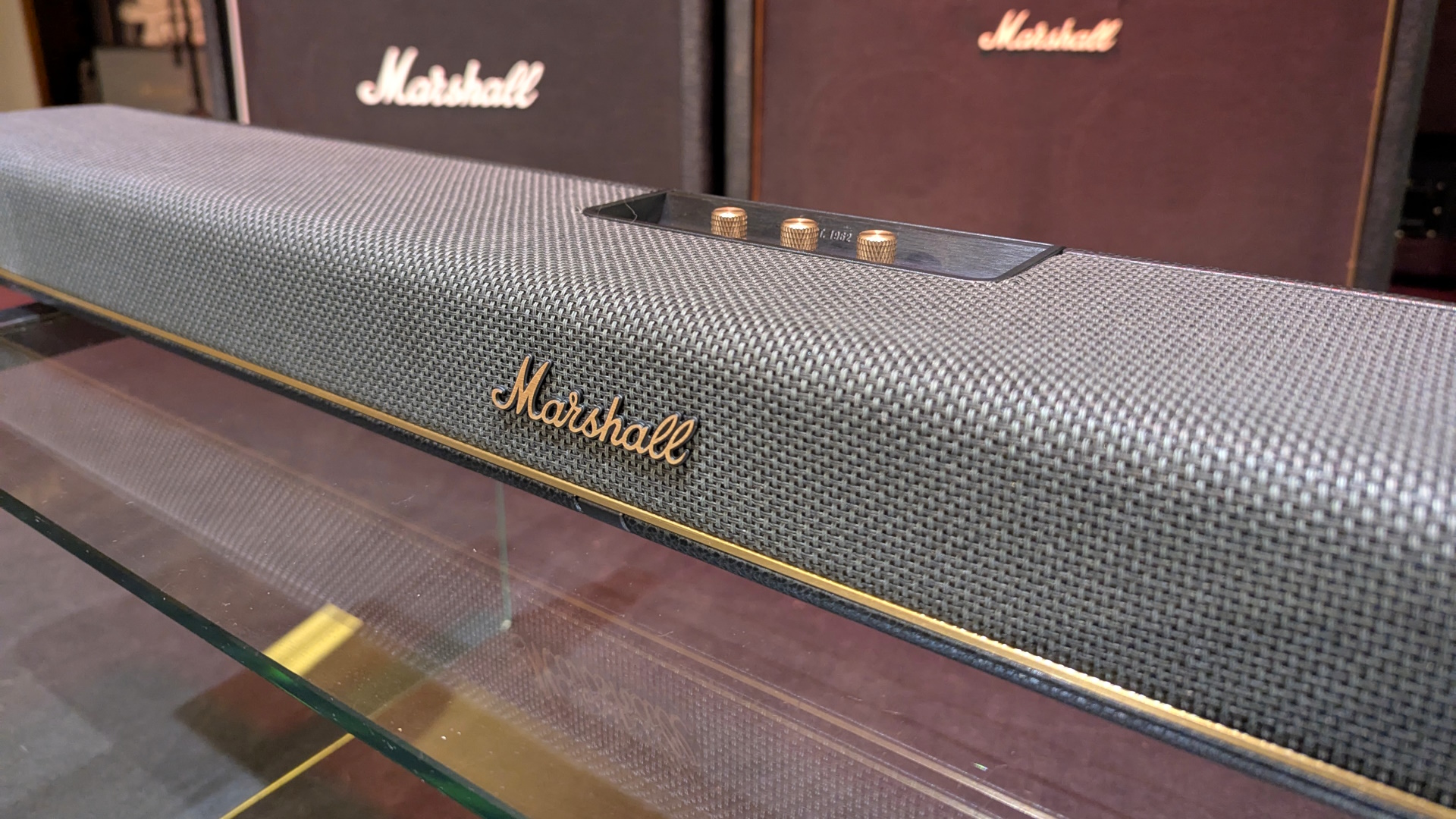
Challenging the black plastic trend – Marshall's first soundbar, the Heston 120 with Dolby Atmos, put to the test
Where sound meets style.
The Heston 120 launches on 20 May. We had the chance to test the stylish soundbar at home ahead of release. So how does Marshall's first-ever soundbar with 11 drivers hold up?Christian Hintze, 👁 Christian Hintze, ✓ Louise Burke (translated by DeepL / Ninh Duy) Published 🇩🇪 🇫🇷 ...
Sound check complete – big sound, bold design, versatile features, with a premium price tag
As expected from Marshall, the Heston 120 delivers a sonic performance that doesn't disappoint. The sound is crisp and articulate, with a muscular presence — especially during films, where it unleashes a forceful, almost ferocious intensity. Only in the most demanding moments does the bass occasionally soften in detail, but for those seeking extra depth, the sub-out offers an easy path to an external subwoofer.
Design, too, is where Marshall plays to its strengths. The Heston 120 is more than a speaker — it's a statement piece. This is a soundbar made to be seen, not hidden, and it's bound to draw admiring glances and curious questions from guests. In a world of identical black plastic rectangles, it's a standout — a welcome shift in a sea of sameness.
Still, there are compromises. The unit takes a full 20 minutes of silence before entering standby mode, and the lack of a dedicated power switch might irk some users. And with a price tag of around €1,000 (approximately $1,080 USD), the Heston 120 makes no claim to affordability.
Pros
Cons
Price and availability
The Heston 120 will be available from 3 June on Marshall.com for €999 (approximately $1,080 USD).
Table of Contents
- Sound check complete – big sound, bold design, versatile features, with a premium price tag
- Specifications – 11 built-in drivers including 2 dedicated woofers
- Housing and features – stylish on the outside, powerful on the inside
- Marshall App – seamless setup, total control
- Practical test and sound performance – impressively powerful
- Power consumption – no power switch
- Conclusion
Marshall, the legendary heritage brand best known for its iconic guitar amps of the 1960s, has since expanded across the entire audio landscape. Until now, however, a soundbar had been missing from its lineup. Tired of the endless parade of lookalike black plastic bars from other manufacturers, Marshall's designers set out to create something with more style, more versatility, and that unmistakable Marshall sound. Enter the Marshall Heston 120.
Later this year, Marshall is expected to follow up with a smaller model, the Heston 60, as well as a dedicated subwoofer dubbed the Heston Sub 200.
Specifications – 11 built-in drivers including 2 dedicated woofers
| Drivers | 2 subwoofers + 2 midrange drivers + 2 tweeters + 5 high-frequency drivers |
| Amplifier | Class-D, 2 × 50 W (subwoofer) + 9 × 30 W |
| Total audio power | 150 W |
| Configuration | 5.1.2 |
| Frequency range | 40 Hz – 20 kHz |
| Max. SPL | 95.5 dB @ 1 m |
| Audio codecs | Dolby Atmos, DTS:X, SBC, LC3, AAC (MPEG-4), ALAC, FLAC, LPCM, Ogg Vorbis, WMA, WMA9 |
| Wireless | Bluetooth 5.3 (including Bluetooth 5.1 Classic), Wi-Fi 6 |
| Wi-Fi services | Tidal Connect, Spotify Connect, AirPlay 2, Google Cast |
| Connections | 2 × HDMI 2.1, RCA L/R, subwoofer out, USB-C out (5 V, 500 mA), LAN/RJ45 (10/100 Mbit), power |
| Microphones | 2 for calibration |
| Dimensions | 1,100 × 145 × 76 mm |
| Weight | 7.34 kg |
Housing and features – stylish on the outside, powerful on the inside
"We can make a soundbar that's sleeker and more stylish than this" — that's likely what Marshall's designers had in mind. After all, the company is aiming to win over audio enthusiasts who have no interest in placing one of those typical glossy black plastic soundbars from other brands on their TV stand. Even the packaging sets the tone — a design homage to the punchy guitar sound that made Marshall famous.
The Heston 120’s chassis may technically be made of plastic, but you'd hardly know it from the signature Marshall styling. The top and front are wrapped in a woven mesh of durable paper fibres, while the front displays Marshall's iconic script logo in brass-coloured aluminium. A slim, elegant metal strip runs just beneath it, stretching nearly the entire width of the 1.10-metre soundbar. All metallic elements — including the buttons, trim, and logo — have a brass-like finish, though they are made from aluminium.
The edges are finished in a textured faux-leather wrap, and at the centre of the top panel sit the carefully designed controls. Manual operation has always been central to Marshall's identity, both functionally and stylistically. The Heston 120 features full-sized, textured rotary knobs for volume (synchronised with your Bluetooth device or smartphone), bass/treble adjustment, and input selection. They are modelled after the knobs found on classic Marshall amplifiers. Sound presets and user memory slots are controlled via a small, brass-coloured push button. A dedicated power switch is not included.
Visually, the Heston 120 feels significantly more refined than most competing models — a quick browse through Amazon's soundbar listings makes the difference clear.
According to Marshall's R&D team, many users don’t limit their soundbar to just TV and films — they use it to play nearly all the music they listen to. That's why, from the start, a key goal in developing the Heston was to move beyond the concept of a traditional TV soundbar. Versatility was a priority, and the result is a universal home speaker system. To support this, the Heston offers a wide soundstage powered by multiple drivers and tailored presets for different listening modes (Music, Movie, Night, and Voice).
To ensure a room-filling experience that isn't dependent on the listener's position, the speaker is designed to radiate sound evenly in all directions. The Heston 120 uses a total of 11 internal drivers, each oriented to project sound purposefully. On the front, three tweeters handle clear vocals. These are supported by another pair mounted on the sides of the enclosure, angled slightly forward to widen the soundstage.
On the top panel, two midrange drivers are positioned at the edges, firing upward. Next to them are a pair of tweeters that direct sound diagonally toward the ceiling, using reflections to create spatial height. Additionally, two custom-designed subwoofers are built into the casing. They reproduce frequencies as low as 40 Hz and deliver the low-end punch that gives the Heston its distinctive depth.
The subwoofers are powered by two dedicated Class-D amplifiers rated at 50 watts each. The remaining nine drivers each operate on 30 watts.
From a connectivity perspective, the Heston includes Bluetooth, Wi-Fi, a LAN port, and RCA (Cinch) inputs. A standout feature is the sub-out, which allows an external subwoofer to be connected for even more low-end impact. There are also two HDMI ports, one of which supports eARC for seamless integration with a TV. Additionally, there is a compact USB-C output that is primarily used for service access, but it can also supply power to other devices at 5 V and up to 500 mA. The two built-in microphones are not intended for incoming calls and are used solely for calibration.
Sustainability
According to Marshall, the Heston 120 is made from 38 percent plastic, 74 percent of which is recycled material. The product is entirely PVC-free, and the leather used is vegan, water-based, and DMFa-free. All driver magnets contain recycled pre-consumer neodymium, a rare earth element.
Marshall App – seamless setup, total control
Launched alongside the Heston 120, Marshall's new app is designed to unify control across all future devices. The former "Marshall Bluetooth App" has now been streamlined and renamed simply the "Marshall App." Visually, the interface will feel familiar, as little has changed in terms of design.
No account is required upon first launch. Pairing the Heston 120 via Bluetooth is quick and straightforward, and location access is not necessary. Optionally, users can connect the app to their home Wi-Fi network to enable direct access to Spotify, Tidal, and other streaming services.
Shortly after setup, the app prompts users to install the first firmware update for the Heston 120. Once complete, the two built-in microphones are used to measure and calibrate the room acoustics.
Only after completing this process is the clean and well-organised home screen revealed. It is divided into three tabs: Home, Marshall, and More. Most settings can be adjusted directly from the main screen, including volume, sound modes, input source, and the equaliser.
What's more, the three physical preset buttons on the Heston can be linked to services like a radio station or Spotify. However, this specific feature does require the use of the app.
Practical test and sound performance – impressively powerful
Once the power cable is connected, you're ready to go. The TV connects via HDMI using eARC or ARC. If you want to stream from your smartphone, simply turn the source selector to Bluetooth, press the knob, and pair the phone. The app isn't strictly required for this step. However, we did notice some latency between picture and sound during Bluetooth playback.
The sound is exceptionally powerful for a soundbar, with the subwoofers delivering serious punch. We were impressed by the force the Heston produces despite its slim form factor. The bass isn't just audible — in some scenes, it's physically felt. High frequencies are clear and easy to localise.
That said, in effects-heavy films, the sound can lose some resolution and the bass can start to overpower, occasionally lacking in finer detail. A good example is the animated series Secret Level, where not only the Warhammer scenes but others as well suffer from heavy-handed bass. Most of the time, though, the low end is impressive and enjoyable — and can be adjusted using the dedicated rotary knobs.
As for the Atmos effects, our impressions are mixed. We remained somewhat sceptical about whether a front-facing speaker could deliver a convincing surround experience. In a few Atmos test scenes (played via HDMI), we did notice a sense of spatial audio, particularly with birdsong or subtle environmental sounds. However, in most cases, the soundstage felt anchored to the front.
Power consumption – no power switch
Marshall officially lists the Heston 120's standby consumption as follows: energy-saving mode < 0.27 W, network standby < 1.5 W, and "semi-active mode" < 6.4 W. In our own measurements, with no LAN connection, the standby power draw was approximately 1.5 W. When idle with no audio source, consumption hovered around 6 W.
At 40 to 50 percent volume, power usage ranged between 6.5 and 8.5 W while streaming internet radio or playing a track from a smartphone via Bluetooth (using VLC). Increasing the volume to 80 percent caused power consumption to fluctuate significantly, from 20 to 37 W. In demanding home cinema scenarios with action-heavy films, usage is likely to be even higher.
Since the Heston lacks a physical power switch, it only enters power-saving mode after 20 full minutes without an audio signal.
Conclusion
Bold in both sound and design, the Marshall Heston leaves a lasting impression, though it comes at a price.
Transparency
The selection of devices to be reviewed is made by our editorial team. The test sample was given to the author by the manufacturer free of charge for the purposes of review. There was no third-party influence on this review, nor did the manufacturer receive a copy of this review before publication. There was no obligation to publish this review. As an independent media company, Notebookcheck is not subjected to the authority of manufacturers, retailers or publishers.
















































